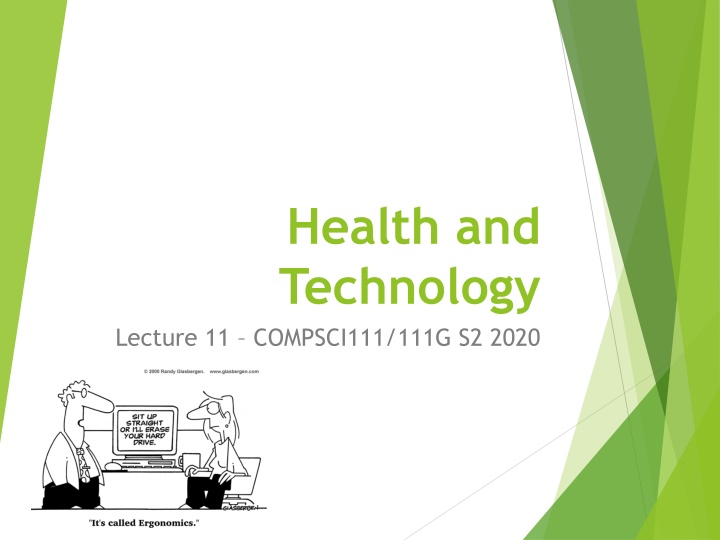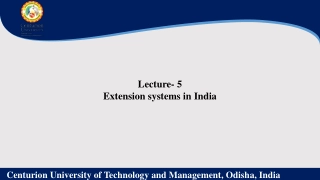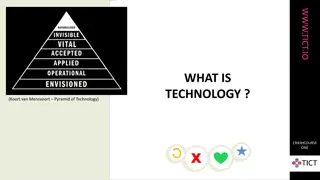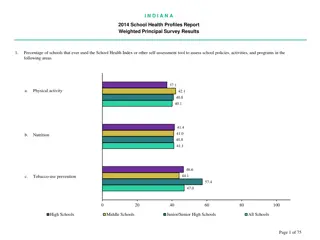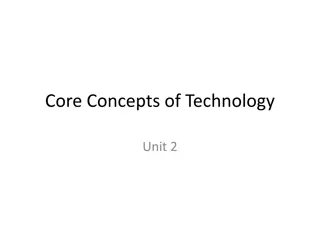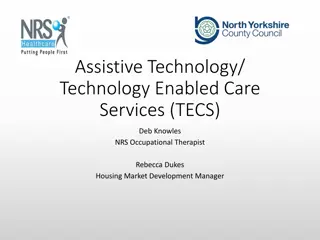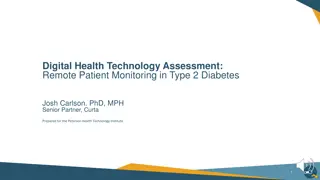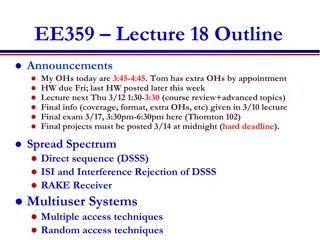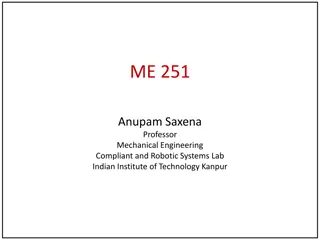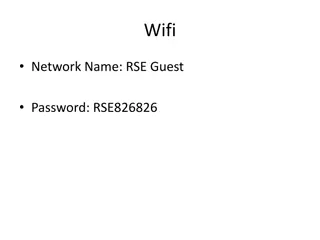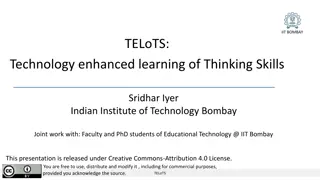Impact of Technology on Health - Lecture Insights
Technology has a significant impact on our health, with some repercussions being negative. This lecture discusses various health issues related to technology, including psychological disorders, physical health concerns, distractions caused by digital devices, instant gratification expectations, narcissism associated with social media, mood disorders linked to excessive technology use, and deficits in social skills due to increased interaction with technology.
Download Presentation

Please find below an Image/Link to download the presentation.
The content on the website is provided AS IS for your information and personal use only. It may not be sold, licensed, or shared on other websites without obtaining consent from the author.If you encounter any issues during the download, it is possible that the publisher has removed the file from their server.
You are allowed to download the files provided on this website for personal or commercial use, subject to the condition that they are used lawfully. All files are the property of their respective owners.
The content on the website is provided AS IS for your information and personal use only. It may not be sold, licensed, or shared on other websites without obtaining consent from the author.
E N D
Presentation Transcript
Health and Technology Lecture 11 COMPSCI111/111G S2 2020
Health and Technology Technology has a large impact on our lives, not all of it positive. We will discuss the following types of health issues related to technology: Psychological Physical
Psychological Issues iDisorders
Distraction [1] Digital devices are highly pervasive and are demanding of our attention. Cognitively penetrating Checking repeatedly accessing your digital device interrupting your current activity. A 2012 study of 777 students at 6 U.S. universities found that : On average a student used a digital device for non- class purposes 11 times during a typical school day. 80% indicated that such behaviour caused them to pay less attention in class and miss instruction.
Instant Gratification [2] The desire to experience pleasure or fulfilment without delay or deferment. You want it, and you want it now. Always online digital devices have raised the expectation for immediate gratification. E.g. expecting immediate responses to social media posts or texts. Has resulted in: Increased impatience Unrealistic expectations checking
Narcissism [3] Personality trait characterized by a grandiose sense of self-importance. Engage in self-promotion, vanity and superficial relationships. Younger people show a stronger urge to report their activities and believe their social media audience care about them. A 2009 study of 16000 college students in the US found that they scored substantially higher on the Narcissism Personality Inventory than their cohort 20 years ago. Studies have suggested social media exacerbates and even encourages narcissism. Users may tailor their profile pictures, status updates, biographies and even lists of friends in order to appear more attractive.
Mood Disorders [3] Extensive evidence documenting a relationship between depression and technology. Excessive texting, viewing video clips, video gaming, chatting etc. Depression may be transmittable through technological interaction. Consumption of depressing media, particularly movies and music can induce a negative affect. emotional contagion
Deficits in Social Skills [4] Increased interaction with technology has led to a reduction in human interaction. Face-to-face communication skills are negatively affected. Visual cues are an important part of face-to-face communication. Includes facial expression, eye contact, tone of voice, posture, and spatial distance. Need to be able to modify one s own behaviour in response to the reactions of others. A 2014 study of 105 U.S. children was carried out. 51 children in the test group did not use digital devices for 5 days only face-to-face communication. 54 children in the control group continued to use their digital devices. Test group recognition of nonverbal emotional cues was significantly better than that of the control group.
Computer Vision Syndrome [5] Results from focusing eyes on a computer or other display device for long, uninterrupted periods of time. Symptoms of CVS include: Dry eyes Blurred/double vision Eyestrain Red/irritated eyes Treatment/Prevention: Proper lighting within computer workstation area Appropriated screen distance and position Work breaks Lubricating eye drops
Hearing Loss [6] Listening to media through headphones or earbuds for prolonged periods of time at high volume can cause permanent hearing loss. A 2005 2006 study reported that 19.5% of American adolescents aged 12 to 19 suffered from hearing loss. An increase of 33% from that reported in 1988 1994. Some of this increase may be attributable to headphone/earbud usage. Prevention: Lower volume. If other people can hear the music you are listening to it is most probably too loud. Limit exposure. Moderate noise on a regular basis can lead to hearing loss.
Occupational Overuse Syndrome [7, 8] Also referred to as Repetitive Strain Injury (RSI). Umbrella term for range of conditions characterized by: Muscle discomfort Aches and pains Muscle tightness and spasms Numbness and tingling Pain may eventually become constant and associated with loss of muscle strength and sleep disturbances. Factors that can lead to OOS developing include: Repetitive movement e.g. typing Awkward postures e.g. sitting at a desk Poor ergonomics Psychosocial factors excessive workload, impending deadlines Poor work practices - e.g. poor time management
Occupational Overuse Syndrome [7, 8] There are a number of steps that can be taken to prevent OOS. From a workplace perspective: Design equipment and tasks with people in mind e.g. ergonomic workstations. Pay attention to work environment e.g. lighting. Train and educate all staff. From a personal perspective: Stop activity when discomfort is felt Maintain correct posture Take regular breaks Avoid prolonged, repetitive movement or activity Manage stress levels Educate yourself about OOS prevention
General Solutions for Healthy Use of Technology Take breaks both large and small. Moderate your social media presence. Try cutting down the number of posts or status updates you make each day. Are you posting for narcissistic reasons or with communication as a goal? Give your work or entertainment space an ergonomic makeover. Pay attention to lighting, chair, display position etc. Maintain a healthy lifestyle. Appropriate diet Exercise No smoking
Summary Technology can have a negative effect on your health. Psychological Issues: Distraction Instant gratification Narcissism Mood disorders Deficits in social skills Physical issues Computer Vision Syndrome (CVS) Hearing loss Occupational Overuse Syndrome (OOS)
References [1] B. R. McCoy, Digital Distractions in the Classroom: Student Classroom Use of Digital Devices for Non-Class Related Purposes, Journal of Media Education, vol. 4, no. 4, pages 5 14, 2013. [2] R. Alsop, Instant Gratification and its Dark Side, 2014, Bucknell Magazine, Available: https://www.bucknell.edu/about-bucknell/communications/bucknell-magazine/recent-issues/summer- 2014/instant-gratification-and-its-dark-side [3] L. D. Rosen, K. Whaling, S. Rab, L. M. Carrier, and N. A. Cheever, Is Facebook creating iDisorders ? The link between clinical symptoms of psychiatric disorders and technology use, attitudes and anxiety, Computers in Human Behavior, vol. 29, issue 3, pages 1243 1254, 2013. [4] Y. T. Uhls, M. Michikyan, J. Morris, D. Garcia, G. W. Small, E. Zgourou, and P. M. Greenfield, Five days at outdoor education camp without screens improves preteen skills with nonverbal emotional cues, Computers in Human Behavior, vol. 39, pages 387 392, 2014. [5] C. Blehm, S. Vishnu, A. Khattak, S. Mitra, and R. W. Yee, Computer Vision Syndrome: A Review, Survey of Opthalmology, vol. 50, issue 3, pages 253 262, 2005. [6] L. Soltan, Technology and Hearing Loss, 2016, Digital Responsibility, Available: http://www.digitalresponsibility.org/technology-and-hearing-loss [7] Occupational overuse syndrome (OOS), 2017, Southern Cross Medical Library, Available: https://www.southerncross.co.nz/group/medical-library/occupational-overuse-syndrome-oos [8] Guidelines for using computers preventing and managing discomfort, pain and injury, Department of Labour, 2010, Available: https://www.acc.co.nz/assets/injury-prevention/acc5637-computer-use.pdf
